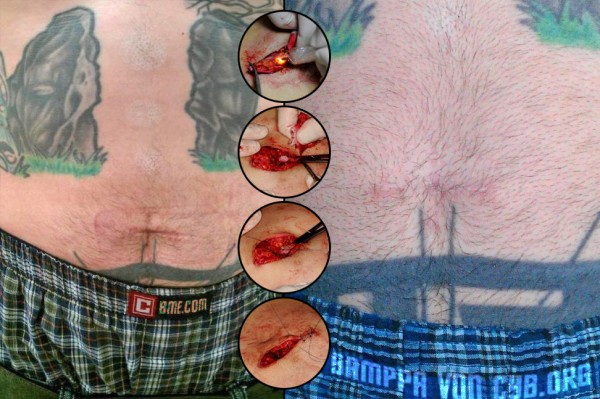In terms of his body, the singular thing that should separate Adam (as in the myth of “Adam and Eve”) from all other humans is that he doesn’t have a navel, seeing as he was sculpted out of mud rather than being birthed of a woman. A navel of course is the scar that remains from the severed umbilical cord, proof of mammalian birth, something that every human other than the first man, created by the hand of god in his own image, bears. This makes the navel removal procedure interesting to me — metaphorically it disconnects a person from their “long chain of biological reproduction”, turns them into a being sculpted not by biology, but by “the hand of god”. In this case, the hand of god could be the body modification practitioner, or even the person themselves, so I really appreciate what the procedure says — that we are our own gods, dictating our own fates and morphology.
Of course, some people just like the way it looks, and I don’t want to attach meaning to other people’s mods — I just really enjoy the musing one can do about this rare piece of body art. There are of course many other tales and motivations one could attach to it (for example, “f* you mom!”), like any other procedure.
Above is a navel removal — click to enlarge — done by Samppa Von Cyborg (voncyb.org), one of the only people I’d trust to do this advanced procedure. The left photo shows it at two months into healing, and on the right side it’s at eleven months. Down the middle you can see photos from a navel removal procedure (on a different person, but the procedure is the same). As you can see, the basic steps are skinning the navel down to its base and then closing it with a combination of internal and external sutures. I think it’s very important to note that as “easy” as that may seen, this is an extremely difficult procedure. On an aesthetic level, it takes a profound knowledge of the way the body heals and the anatomy — an understanding of the navel’s structure and a detailed knowledge of the way the collagen fibers run so they can be appropriately bonded, plus the ability to apply that understanding the the significant difference from person to person — to do this procedure inside an acceptable margin of safety.
Without that knowledge the procedure will almost certainly simply replace the original “navel scar” with a different sort of scar, to say nothing of the health risk. The APP has in the past warned that “outie” navels should not be done because an infection could travel inward along the old scar to the liver (which the umbilical cord once attached to). I don’t share that analysis, but I do agree that an infection trapped inside a navel removal, perhaps due to incomplete excision of tissue (for example a hair follicle) or any number of potential mistakes, could easily become life threatening.

 BME/News and Modblog highlight only a small fraction of what
BME/News and Modblog highlight only a small fraction of what
I know of someone whose parents made the decision to sew it at birth rather than tie it. The effect is pretty much the same, but less scarring.
I know of someone whose parents made the decision to sew it at birth rather than tie it. The effect is pretty much the same, but less scarring.
That original info actually came from Anne Greenblatt on the rec.arts.bodyart Piercing FAQ: http://www.faqs.org/faqs/bodyart/piercing-faq/jewelry/partD/
I did some additional research on “outie navels” before putting the following in my book, The Piercing Bible:
“A hardened outie that is scarlike may be a remnant of your umbilical cord. There is some chance it could be connected to the interior of your abdomen and internal organs. An infection of an outie piercing could travel rapidly to your peritoneum (membrane lining the abdominal cavity) or your internal organs, presenting serious health risks.
The outie that is softer and pushes in easily is probably an umbilical hernia. Some of your intestines can poke through this type of herniation, which is a weakness or hole in the abdominal lining near your navel. If this tissue is pierced, there is a possibly of puncturing your small intestine, which could obviously be extremely serious. If there is a flap of skin above the protrusion, it could be pierceable, if it is distant enough from your hernia. A combination “innie-outie” structure is generally unsuited to vertical placement. An experienced piercer can determine if the tissue surrounding your outie presents any safe options for piercing.
More info: David Schlossberg. Infections of Leisure (Herndon, VA: ASM Press, 2004), 409.
That original info actually came from Anne Greenblatt on the rec.arts.bodyart Piercing FAQ: http://www.faqs.org/faqs/bodyart/piercing-faq/jewelry/partD/
I did some additional research on “outie navels” before putting the following in my book, The Piercing Bible:
“A hardened outie that is scarlike may be a remnant of your umbilical cord. There is some chance it could be connected to the interior of your abdomen and internal organs. An infection of an outie piercing could travel rapidly to your peritoneum (membrane lining the abdominal cavity) or your internal organs, presenting serious health risks.
The outie that is softer and pushes in easily is probably an umbilical hernia. Some of your intestines can poke through this type of herniation, which is a weakness or hole in the abdominal lining near your navel. If this tissue is pierced, there is a possibly of puncturing your small intestine, which could obviously be extremely serious. If there is a flap of skin above the protrusion, it could be pierceable, if it is distant enough from your hernia. A combination “innie-outie” structure is generally unsuited to vertical placement. An experienced piercer can determine if the tissue surrounding your outie presents any safe options for piercing.
More info: David Schlossberg. Infections of Leisure (Herndon, VA: ASM Press, 2004), 409.